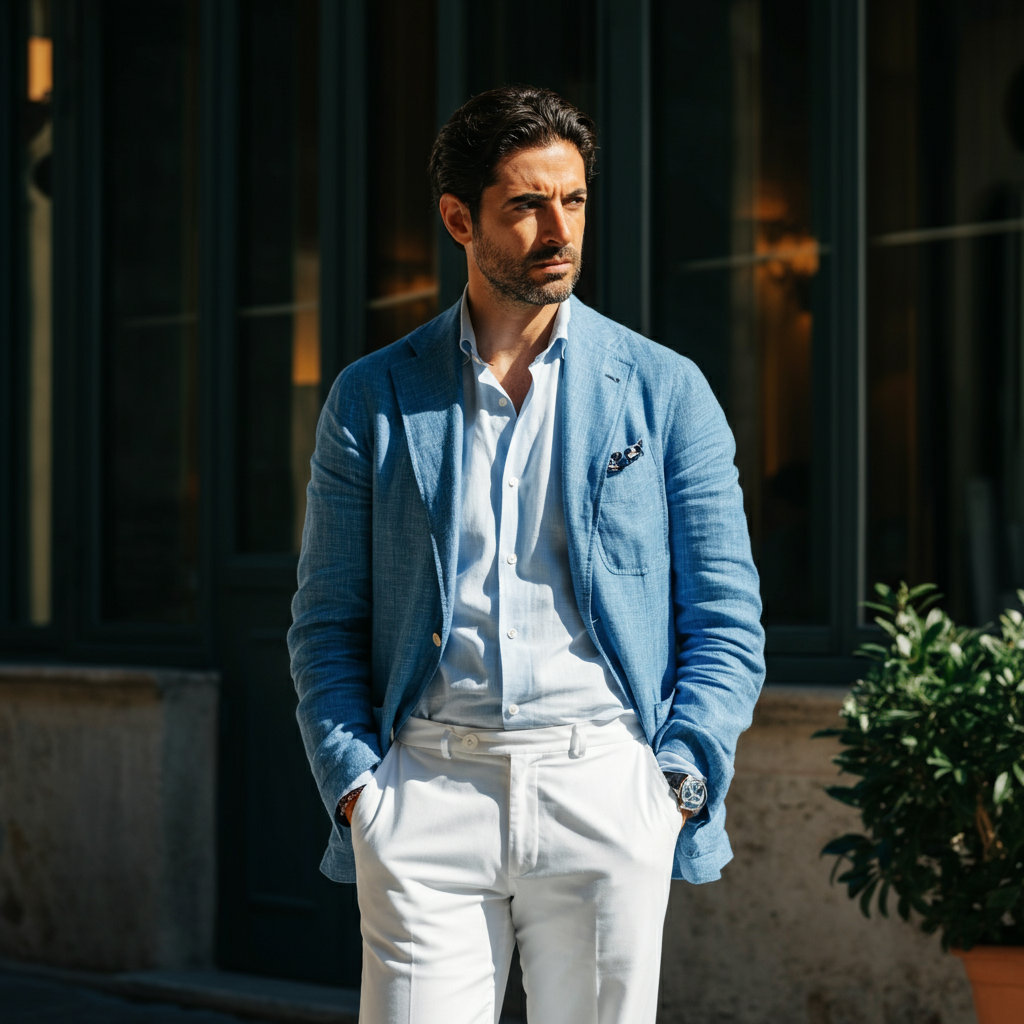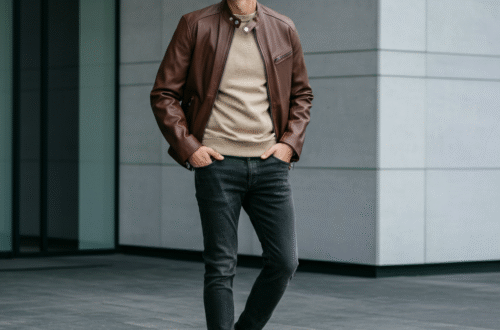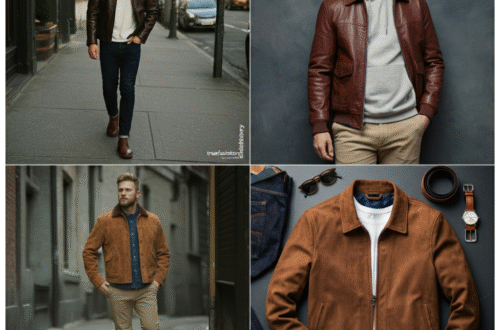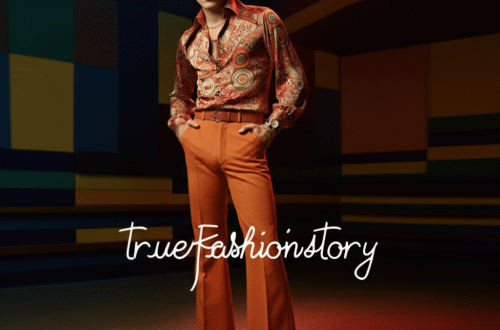italian mens fashion is recognized globally for its elegance, quality craftsmanship, and seemingly effortless style. It’s a look that combines classic tailoring with a modern, confident attitude. But what exactly makes it so special? It’s more than just wearing expensive brands; it’s about a philosophy of dressing well, known as ‘la bella figura,’ or making a beautiful impression. This guide will walk you through everything you need to know to master this iconic style, from essential pieces to the unwritten rules that define it.
Key Takeaways
- Sprezzatura is Key: The art of studied carelessness is central to Italian style. It’s about looking perfectly put-together without appearing like you tried too hard.
- Fit is Everything: Italian fashion prioritizes a tailored fit. Clothes should skim the body, enhancing your silhouette without being restrictive.
- Quality Over Quantity: Invest in high-quality fabrics and well-made garments that will last. Think cashmere, linen, fine wool, and supple leather.
- Embrace Color and Accessories: Don’t be afraid of color. Italian men confidently wear pastels, jewel tones, and earthy shades. Accessories like a quality watch, leather loafers, or a silk pocket square complete the look.
The Philosophy of Italian Style: Sprezzatura
At the heart of Italian men’s fashion lies the concept of sprezzatura. This term, first appearing in the 16th century, means “studied carelessness.” It’s the art of looking impeccably stylish in a way that seems completely natural and without effort. Think of a perfectly tailored blazer paired with slightly unbuttoned cuffs, or a tie with a purposefully imperfect knot. It’s the small, intentional details that break the rules of formal dressing just enough to show personality and confidence. Achieving sprezzatura isn’t about being sloppy; it’s about mastering the rules so you can bend them with intention. This philosophy is why Italian men often look so relaxed yet sophisticated at the same time.
How to Achieve Sprezzatura
- Leave your shirt cuff buttons undone.
- Opt for a slightly loosened tie knot.
- Drape a sweater over your shoulders instead of wearing it.
- Wear high-quality loafers without socks in warmer weather.
- Mix formal pieces (like a blazer) with casual ones (like denim).
The Importance of Tailoring and Fit
If there’s one non-negotiable rule in Italian men’s fashion, it’s the paramount importance of fit. Italian tailoring, particularly the Neapolitan style, is famous for its soft shoulders, high armholes, and lightweight construction. This creates a silhouette that is sharp yet comfortable, moving with the body rather than restricting it. A jacket should accentuate your shoulders and taper at the waist. Trousers should have a clean line, with a gentle break at the ankle—never pooling around your shoes. Even casual items like t-shirts and knitwear are chosen to flatter the physique. You don’t need a custom-made wardrobe, but having a trusted tailor to make small adjustments to your off-the-rack purchases can make a world of difference.
Essential Wardrobe Staples for the Italian Look
Building a wardrobe inspired by Italian men’s fashion is about curating a collection of versatile, high-quality pieces. These are the foundational items that you can mix and match to create countless stylish outfits.
The Unstructured Blazer
The quintessential piece of Italian men’s fashion is the unstructured blazer. Unlike its more rigid British or American counterparts, the Italian blazer often lacks heavy shoulder padding and a full lining. This makes it incredibly lightweight, comfortable, and perfect for layering. It drapes naturally over the shoulders, creating a relaxed but polished silhouette. Look for blazers in versatile fabrics like linen for summer or soft wool and cashmere for cooler months. Navy blue, beige, and soft gray are excellent starting points that can be dressed up with tailored trousers or down with quality jeans.
Perfectly Tailored Trousers
Forget baggy pants. Italian style calls for trousers that are slim, well-fitted, and tailored to perfection. The preferred cut is a gentle taper from the knee down, ending with a slight or no break at the ankle. This creates a clean, elongated leg line that works beautifully with loafers or dress shoes. Chinos in shades of beige, olive, and navy are staples for a smart-casual look. For a more formal feel, opt for wool trousers in charcoal gray or navy. During the summer, linen trousers are a must-have for staying cool while looking sharp.
High-Quality Shirts
The foundation of any great outfit is the shirt. For an Italian-inspired wardrobe, focus on quality fabrics and an excellent fit. A crisp white or light blue button-down shirt made from high-quality cotton is indispensable. The collar is also an important detail. A cutaway or semi-spread collar works well with or without a tie and looks great unbuttoned at the top for a more relaxed vibe. Don’t overlook the power of a well-made polo shirt or a simple linen shirt for more casual settings, as both are staples in the Italian man’s summer wardrobe.
Luxurious Knitwear
Italian men are masters of layering, and luxurious knitwear is a key tool in their arsenal. A fine-gauge merino wool or cashmere sweater is a versatile piece that can be worn over a shirt, under a blazer, or simply draped over the shoulders. Crewnecks and V-necks in neutral colors like navy, gray, and camel are timeless investments. In warmer weather, cotton or silk-blend knits offer a lighter option. The goal is to choose knitwear that is slim enough to layer comfortably without adding bulk, maintaining that streamlined Italian silhouette.
Footwear: The Foundation of Your Outfit
In Italy, you can tell a lot about a man by his shoes. Footwear is never an afterthought; it’s a critical component of the overall look. Investing in high-quality, well-maintained shoes is essential.
The Iconic Loafer
The loafer is arguably the most important shoe in Italian men’s fashion. Its versatility is unmatched. A classic leather penny loafer or a suede driving moccasin can be worn with everything from a full suit to shorts. Suede loafers in brown, tan, or navy are particularly popular and embody the relaxed elegance of Italian style. A growing trend is wearing them without socks, especially during the spring and summer, to achieve a nonchalant, sophisticated look.
Classic Leather Dress Shoes
For more formal occasions, a pair of elegant leather dress shoes is a must. While Oxford shoes are a classic choice, many Italian men prefer the slightly less formal but equally stylish Derby or monk strap shoe. A double monk strap, in particular, adds a touch of personality and flair. Stick to classic colors like black, dark brown, or oxblood. The key is the quality of the leather and the sleekness of the shoe’s shape. Regular polishing and proper care will ensure they last for years.
The Art of Accessorizing
Accessories are where you can truly inject your personality into an outfit. Italian men use accessories to add a pop of color, a touch of luxury, and a point of interest.
- Watches: A classic, elegant timepiece is a status symbol and a style statement. It doesn’t have to be the most expensive model, but it should be a quality watch with a timeless design.
- Sunglasses: A pair of well-chosen sunglasses is essential. Classic aviator or Wayfarer styles are popular, but Italian brands like Persol offer iconic and uniquely stylish designs.
- Pocket Squares: A pocket square adds a dash of color and sophistication to a blazer. It should complement your tie, not match it exactly. A silk or linen pocket square with a simple puff fold is a classic sprezzatura move.
- Scarves: In the cooler months, a fine wool or cashmere scarf is both functional and stylish. It can be looped elegantly around the neck to add texture and color to your outerwear.
- Belts: A quality leather belt that matches your shoes is a fundamental rule for a polished look.
Color Palette: Beyond Neutral Tones
While a foundation of neutrals like navy, gray, beige, and white is crucial, Italian men are not afraid of color. They expertly incorporate color in a way that is tasteful and confident. Earthy tones like olive green, terracotta, and ochre are very common. Soft pastels—think light pink, sky blue, and mint green—are staples for shirts and sweaters, especially in the spring and summer. The trick is to use color as an accent. For instance, pair a brightly colored sweater with neutral trousers or add a vibrant pocket square to a navy blazer. If you want more inspiration on color pairings and trends, you can find great articles over at truefashionstory.comBlog.
Italian Style: North vs. South
While we often talk about a single “Italian style,” there are regional differences, most notably between the fashion-forward north (Milan) and the sartorial south (Naples).
|
Feature |
Milan (North) |
Naples (South) |
|---|---|---|
|
Silhouette |
Sharper, more structured, and business-oriented. |
Softer, more relaxed, and deconstructed. |
|
Shoulders |
Often have light padding for a defined shoulder line. |
Natural, unpadded shoulder (spalla camicia). |
|
Fabric |
Heavier wools and more formal fabrics. |
Lightweight wools, linen, and cotton blends. |
|
Vibe |
Modern, international, and trend-focused. |
Classic, artisanal, and timeless. |
Understanding these nuances shows a deeper appreciation for the craft and history behind Italian men’s fashion. The Milanese look is often more powerful and corporate, while the Neapolitan style exudes a sense of leisurely, old-world elegance.
Conclusion
Mastering Italian men’s fashion is less about chasing trends and more about embracing a mindset. It’s about prioritizing quality, celebrating craftsmanship, and understanding the power of a perfect fit. By building a wardrobe of timeless, well-made staples and learning the art of sprezzatura, you can cultivate a style that is both sophisticated and effortlessly personal. Start by investing in a few key pieces—an unstructured blazer, tailored trousers, and quality leather loafers. From there, you can begin to experiment with color and accessories to make the look your own. Dressing well is a form of self-respect, and the Italian approach shows that style can be both enjoyable and empowering.
Frequently Asked Questions (FAQ)
Q1: What is the most important element of Italian men’s fashion?
A1: The most important element is undoubtedly the fit. Italian style is built on a foundation of tailored clothing that enhances the wearer’s silhouette. No matter the quality of the garment, if it doesn’t fit well, it isn’t Italian style.
Q2: Can I wear Italian style in a casual setting?
A2: Absolutely. Italian style is incredibly versatile. A casual look could consist of well-fitted chinos, a high-quality linen shirt, and suede driving loafers. The key is that even the casual pieces are chosen with care and fit perfectly.
Q3: Do I need to buy expensive Italian brands?
A3: No, you don’t need to fill your closet with designer labels. The focus should be on quality, fit, and fabric rather than the brand name. It’s better to have one high-quality, well-fitting blazer from a lesser-known brand than an ill-fitting one from a famous designer.
Q4: How do I incorporate “sprezzatura” without looking sloppy?
A4: The key is intention. Sprezzatura is about making one or two small, deliberate imperfections in an otherwise perfect outfit. For example, if you’re wearing a sharp suit, you might leave the buckles on your monk strap shoes undone. The contrast between the polished outfit and the single casual detail is what creates the effect.





